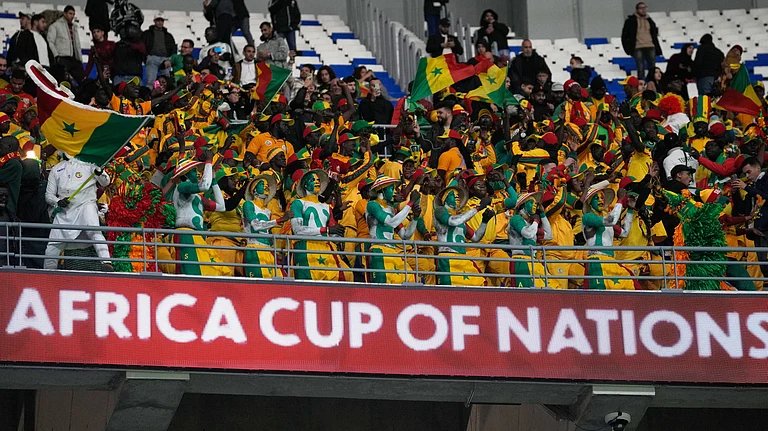The bear hug in the Rose Garden was just the icing on the cake. As foreign visits go, Prime Minister Narendra Modi’s sojourn in the States was seemingly a success even before his plane touched the tarmac in Washington DC.
In anticipation of his visit, the US State Department approved the contentious sale of 22 Guardian drones manufactured by California-based General Atomics to India—signalling an upswing in defence relations. On the eve of the visit, President Donald Trump’s administration designated Pakistan-based Hizb-ul Mujahideen chief Syed Salahuddin a ‘global terrorist’—vindicating India’s stance on cross-border terror. And hours before his arrival, Trump himself tweeted that the Indian prime minister was a ‘true friend’.
What more could Modi ask for? Not a lot, as it turned out.
Modi’s two-day stay in the US reverberated with hand clasps and happy talk. Business matters were high on the agenda and he met a number of American CEOs. The premier also had two meetings with the president and became the first foreign dignitary to be hosted for dinner in the Trump White House. The two leaders issued a joint statement, touching on trade and terrorism, in the lush greens adjacent to the Oval Office—during which Modi eagerly, if awkwardly, hugged Trump.
“Modi got more out of the visit than he might have expected,” said Ashley Tellis, a senior fellow at the Carnegie Endowment for International Peace.
Indeed, prior to the visit, Indo-US relations appeared to be enveloped in a cloud of uncertainty. Trump had won the presidential election last year on an ‘America first’ platform, which entailed withdrawing from international treaties and trade agreements, reducing dependence on foreign imports and focusing on the domestic economy. Such an approach was at odds with Modi’s ‘Make in India’ mantra, which encourages Indian manufacturing and exports to markets such as the US.
Secondly, there was the question of India’s relevance in the broad worldview of the new president—especially in comparison with China. In his meeting with Chinese President Xi Jinping two months ago, Trump had indicated he was willing to let China dominate East and Southeast Asia. This, naturally, was not to India’s liking, as it wants the US to keep China contained, thus allowing India more opportunities to expand its diplomatic and economic footprint in the region.
Finally, just this month, Trump had pulled the US out of the two-year-old Paris global climate accord, claiming that the US had been handed an unfair deal. He had also singled India out as trying to get “billions and billions and billions of dollars in foreign aid” by signing the accord. The Indian foreign ministry refuted Trump’s claim and called it baseless.
India had largely been off Washington’s radar “in the absence of a crisis or of Indian relevance to key immediate US concerns (North Korea, Syria) or of a cabinet member with a keen interest in India,” Tanvi Madan, director of The India Project at The Brookings Institution, said in a policy brief before Modi’s visit. “When the country has been in the American spotlight, the attention has been of the unwanted kind: related to attacks against Indians, criticisms from Trump himself over climate issues, or reports on the president’s businesses in India.”
Given this backdrop, Modi’s US visit does seem like a triumph. Madan’s brief had noted that the PM’s goals would be to “establish a (personal) relationship” with Trump, showcase “the importance of India, and the US-India partnership”, as well as shape Trump’s views on regional security. In less than 48 hours, the Indian PM managed to check all these boxes.
“From an Indian point of view, the visit was an astounding success,” said Tellis, who has authored India’s Emerging Nuclear Posture, among other books on South Asia. “The prime minister turned on the charm. The president kept his most disruptive impulses in check. That made for a personal chemistry that I think was extremely helpful.”
The US move to show its solidarity with India on terrorism was quite dramatic, he added. “For India, that is the most pressing security challenge. So the things they said about combating terrorism in the joint statement and the unilateral decision by the US to designate Syed Salahuddin as a global terrorist—this is nothing but good news to Indian leaders’ ears”.
In the statement, Trump underlined the importance of the “security partnership” between India and the US. “Both our nations have been struck by the evils of terrorism, and we are both determined to destroy terrorist organisations and the radical ideology that drives them. We will destroy radical Islamic terrorism.” The president added that Indo-US military cooperation was also being enhanced. Tellis said this was not just rhetoric, as evident from the move to approve the sale of Guardian drones, “which we haven’t done with any non-ally”.
But these ‘wins’ may have come at a price. Beyond defence procurements and anti-terror cooperation, the joint statement contains several red flags for India.
Trump said “it is important that barriers be removed to the export of US goods into your markets, and that we reduce our trade deficit with your country”. But Indian markets have been opening to US goods for more than a quarter century now. The US trade deficit with India, at $30 billion, is less than a tenth of the US’ $347 billion deficit with China. While candidate Trump had, during his presidential campaign, vowed to reduce that gap, President Trump has backed down from pushing China on the matter. But his joint statement suggests that India—and Modi—is willing to get pushed, even though a change in the balance of trade with the US would severely exacerbate India’s overall trade deficit of $13 billion.
Another red flag is Trump’s hope of “exporting more American energy to India”. This, he said, could include “major long-term contracts to purchase American natural gas”. Although India’s energy needs are substantial and constantly growing, they are largely met by imports from the Persian Gulf. Purchases from the US could undermine long-standing relationships with neighbouring Arab nations, which are already threatened by India’s growing intimacy with Israel.
The absence of some vital issues from the joint statement is just as alarming. One of these is the spate of violence against US-based Indians and people of Indian origin earlier this year—part of a general increase in racist attacks against all people of colour following Trump’s election. Another is the Trump administration’s plan to make it harder for companies to bring in foreign skilled workers on H-1B visas, which are overwhelmingly used by Indian technology professionals. Both these issues have kept the Indian-American community on edge for months—the statement offers little hope that the Indian government is standing up on their behalf.
Trump said in the statement that “relations between countries are strongest when they are devoted to the interests of the people we serve”. But the rest of the statement indicates that—under the veneer of Indo-US solidarity and cooperation—political, corporate, and military interests are the only ones that are being served. India’s obsession with scoring brownie points against Pakistan makes it value symbolic gestures—like the designation of a single individual as a ‘global terrorist’—more than the pressing needs of its people. By tying its coat-tails to that of the US, it also weakens India’s hand and gives other nations an undue advantage in diplomatic negotiations.
By Saif Shahin in Ohio
























